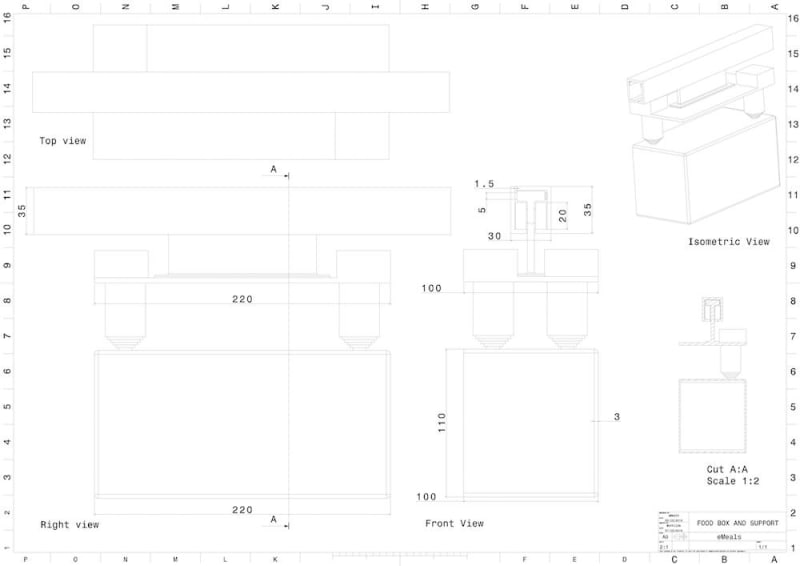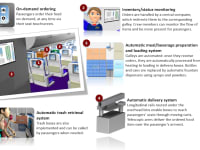Among the most common complaints from passengers when onboard an aircraft are the lack of appropriate legroom and the constraining approach to meal/beverage delivery: trolley blocking aisles, meal service at a specific time, etc.
To help reduce these concerns, a new on-demand ordering system that also automatically loads and delivers meals and beverages to passengers is proposed. Under this new system, the item selection is made through the seat touchscreen and a centralized computer handles the orders and redistributes tasks to automated galleys. An automatic loading system replaces conventional galleys, while fountain drink dispensers using syrups and powders replace bottles and cans. These new galleys automatically prepare passenger orders and load small carts positioned below the overhead bins. These ABS-plastic carts are attached to longitudinal rails, powered by brushed DC motors, and located by RFID sensors. The three-level galleys are similar to existing automated pizza vending machines commercialized by Let’s Pizza. Items move between levels using lifting and conveyor plates operated by pistons. Once the cart reaches the targeted seat, aluminum telescopic arms powered by stepper motors deliver the order to the passenger. While the software and the human-machine interface were developed in Java to optimize the system configuration, the delivery system was designed in Catia and 3D printed.
Even though the production cost of the aircraft increases by 2%, its operating costs are reduced by 1%, resulting in an average of $25,000 annual savings per aircraft. Other concepts, such as Quantum trolleys, only bring about a tenth of those benefits. While the weight added by the new system is compensated by removing trolleys, weight is saved by removing cans and bottles. Hence, 55 tonnes of CO2, 25 tonnes of aluminum and plastic wastes, 38 tonnes of fuel, and 511 GJ of energy are saved each year per aircraft. As such, the system reduces both deplaned wastes and the consumption of natural resources. Moreover, the new smaller galley design enables more space to be redistributed to passengers so that seat pitch can be increased, leading to a 66% improvement in legroom (minimum distance between seats). The waiting times to be served a meal and to go to the lavatories are also improved by 20 min and 12 min, respectively. Therefore, the system improves passengers’ quality of travel by providing more comfort, more freedom, and on-demand services. Besides, crew members’ workload is highly reduced so they can focus more on passengers’ safety and comfort. The system also improves crew members’ quality of life by reducing Repetitive Strain Injuries (RSI) as tedious tasks are avoided: they do not push heavy trolleys and serve meals anymore.
The implementation of this system is also a key enabler of better in-flight entertainment systems and allows airlines to differentiate on their offers and green aspect to better attract passengers. The air transportation market comprises around 3 billion passengers each year. Therefore, by reaching billions of people each year, this novel idea can potentially change the future of aviation.
Video
Like this entry?
-
About the Entrant
- Name:Christopher Frank
- Type of entry:teamTeam members:Christopher Frank: Georgia Institute of Technology
Mathilde Deveraux: Georgia Institute of Technology
Rosemonde Ausseil: Georgia Institute of Technology - Software used for this entry:Catia V5, Blender, JMP, and Matlab
- Patent status:none








